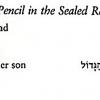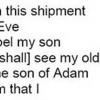3: Poem, “Written in Pencil in the Sealed Railway-Car” by Dan Pagis, 1981, two translations and audio recording.
This is the Pagis poem in the original Hebrew and in two English translations. While the poem is extremely short and fragmentary, it is packed with emotion and possible meaning. The poem’s narrator is Biblical Eve, traveling in a railway car with her son, Abel. Eve wishes to get a message to those who stand outside the railway wagon, but the poem cuts off before we learn what that message is. One possible reading of the poem is that the people Eve is addressing—the people she asks to convey a message to Cain—represent the onlookers who stood by and did nothing as the Holocaust happened.
Suggested Activity: Listen to the poem read aloud in the original Hebrew. Then read the two different English translations, the first of which is by Stephen Mitchell, who translated many Pagis poems in the 1982 volume Points of Departure. The second translation, by Daniel Utley, was published on the website reformjudaism.org. Ask students to reflect on some of the following sets of questions:
What thoughts and questions come immediately to mind just by reading the title of the poem? In Hebrew the words “Katuv” (meaning “Written”) and “Khatum” (meaning “Sealed”) allude to the holiest time of the year for Jews—the time between Rosh Hashanah and Yom Kippur—when Jews are hoping to be “written and sealed in the book of life.” Why might Pagis have used those specific words in his title?
In Hebrew, the singular and plural words for “you” are different. In lines 4 and 6 of the poem the Hebrew plural word for “you” is used rather than the singular. How does this affect your interpretation of the poem? Who is the “you” being addressed?
Why does Eve call Abel “b’ni” (“my son”)? What might Abel represent in this poem? Why does Eve use two terms, b’ni hagadol” (my older son”) and “ben Adam”(“son of man” or “son of Adam”) to describe Cain? What might Cain represent? What does it mean to place these characters on a railway car during the Holocaust? Where do you think Cain is? Why has the poet placed Abel with his mother rather than Cain (who killed Abel in the Biblical story)?
What differences do you notice between the two English translations? If possible, compare the translations to the original Hebrew and ask students why the two translators may have made different choices. How does each translation alter the interpretation of the poem?
What effect does the abrupt ending of the poem have? What do you think Eve’s message for Cain might be?
Source: Reproduced from Points of Departure by Dan Pagis, translated by Stephen Mitchell, by permission of the University of Nebraska Press. Copyright 1982 by The Jewish Publication Society, Philadelphia.
The second translation of the poem, by Daniel Utley, was published on the website reformjudaism.org.
The audio recording was made by Rabbi Robert Sternberg at the Yiddish Book Center in Amherst, MA, 2017.


